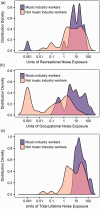The Noise Exposure Structured Interview (NESI): An Instrument for the Comprehensive Estimation of Lifetime Noise Exposure
- PMID: 30295145
- PMCID: PMC6176535
- DOI: 10.1177/2331216518803213
The Noise Exposure Structured Interview (NESI): An Instrument for the Comprehensive Estimation of Lifetime Noise Exposure
Abstract
Lifetime noise exposure is generally quantified by self-report. The accuracy of retrospective self-report is limited by respondent recall but is also bound to be influenced by reporting procedures. Such procedures are of variable quality in current measures of lifetime noise exposure, and off-the-shelf instruments are not readily available. The Noise Exposure Structured Interview (NESI) represents an attempt to draw together some of the stronger elements of existing procedures and to provide solutions to their outstanding limitations. Reporting is not restricted to prespecified exposure activities and instead encompasses all activities that the respondent has experienced as noisy (defined based on sound level estimated from vocal effort). Changing exposure habits over time are reported by dividing the lifespan into discrete periods in which exposure habits were approximately stable, with life milestones used to aid recall. Exposure duration, sound level, and use of hearing protection are reported for each life period separately. Simple-to-follow methods are provided for the estimation of free-field sound level, the sound level emitted by personal listening devices, and the attenuation provided by hearing protective equipment. An energy-based means of combining the resulting data is supplied, along with a primarily energy-based method for incorporating firearm-noise exposure. Finally, the NESI acknowledges the need of some users to tailor the procedures; this flexibility is afforded, and reasonable modifications are described. Competency needs of new users are addressed through detailed interview instructions (including troubleshooting tips) and a demonstration video. Limited evaluation data are available, and future efforts at evaluation are proposed.
Keywords: noise-induced hearing loss; occupational noise; public health; risk; self-report.
Figures


References
-
- Beach E. F., Gilliver M., Williams W. (2013) The NOISE (Non-Occupational Incidents, Situations and Events) database: A new research tool. Annals of Leisure Research 16(2): 149–159. doi:10.1080/11745398.2013.793157.
-
- Beach E. F., Williams W., Gilliver M. (2012) The objective-subjective assessment of noise: Young adults can estimate loudness of events and lifestyle noise. International Journal of Audiology 51(6): 444–449. doi:10.3109/14992027.2012.658971. - PubMed
-
- Berger, E. H., Neitzel, R., & Kladden, C. (2015). Noise Navigator™ sound level database with over 1700 measurement values (version 1.8). Retrieved from https://multimedia.3m.com/mws/media/888553O/noise-navigator-sound-level-....
-
- British Standards Institution. (2017). BS EN 60065:2014+A11:2017: Audio, video and similar electronic apparatus—Safety requirements. https://shop.bsigroup.com/ProductDetail/?pid=000000000030338899.
Publication types
MeSH terms
Grants and funding
LinkOut - more resources
Full Text Sources
Other Literature Sources
Medical

